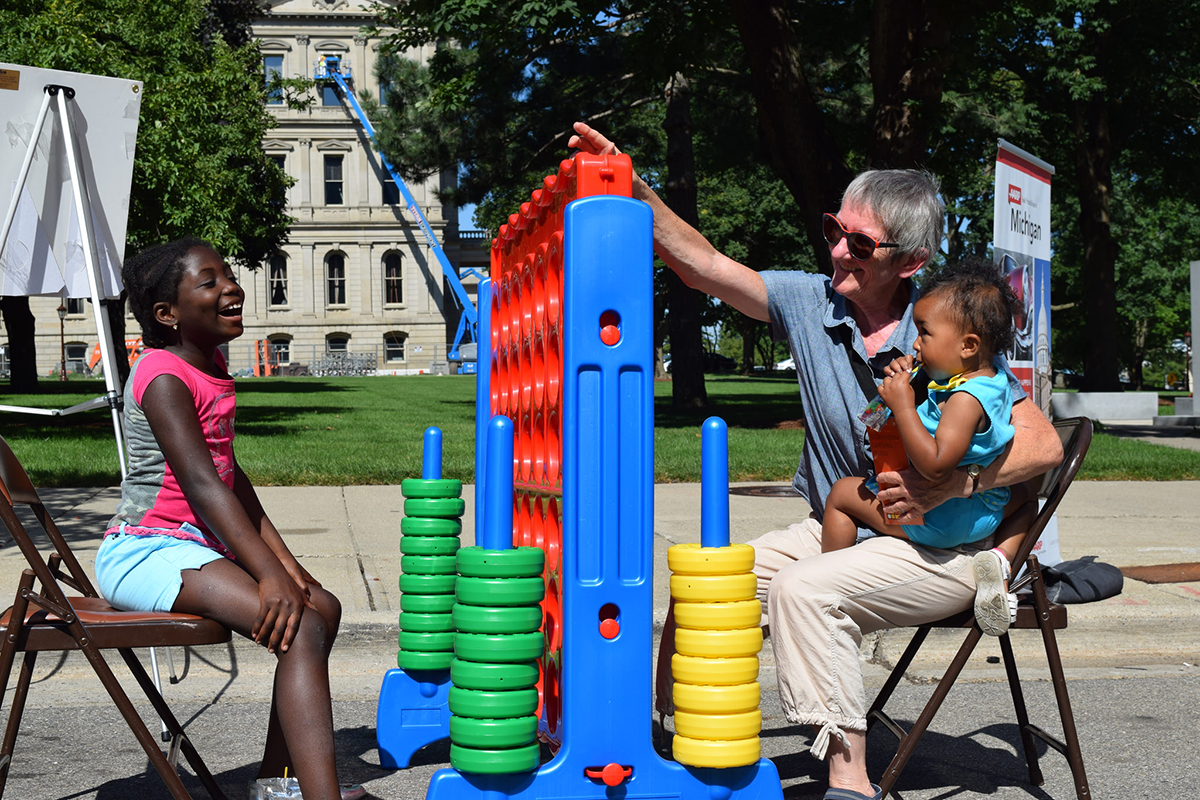On PARK(ing) Day, five things open data advocates can learn from tactical urbanism
 A family plays Connect Four at Convert Capitol Avenue Week in downtown Lansing, MI. Photo by Michigan Municipal League via Flickr.
A family plays Connect Four at Convert Capitol Avenue Week in downtown Lansing, MI. Photo by Michigan Municipal League via Flickr.
Today is PARK(ing) Day, the annual, global event where artists, designers, and residents transform parking spots into temporary public parks. The first PARK(ing) Day was in San Francisco in 2005, when Rebar came up with the idea. In the decade since, nearly 1,000 “parklets” have been created in 162 cities in 25 different countries.
PARK(ing) Day and parklets are some of the original examples of what planners and neighborhood advocates call “tactical urbanism,” which applies flexible, short-term projects to advance long-term civic goals like street safety, public health, and economic activity. Tactical urbanism’s emphasis on low-cost projects that can be easily changed based on resident feedback and observed behavior gives communities a chance to think creatively about how public spaces are built. At its most radical, residents themselves are empowered to directly improve public space. In more official versions, public agencies, like departments of transportation, can apply tactical urbanism to try an idea and see how the community reacts before making it permanent. In many cases, communities have liked these temporary interventions so much they decided to make them permanent.
Tactical urbanism is one of the major inspirations for Tactical Data Engagement, a new part of Sunlight’s work helping cities use open data to solve community problems. Cities across the country are already making public data more open and accessible to residents through open data policies and websites. Tactical Data Engagement is the next step in this work. Like tactical urbanism, Tactical Data Engagement is about observing a community’s needs, experimenting with short-term and low-cost ways to meet those needs together with members of the community, and iterating based on feedback.
To that end, tactical urbanism has a lot to teach open data advocates. Here are a few of the ideas that inspired us.
Put people first
Nearly every tactical urbanism intervention—whether it’s a pop-up park or a crosswalk where there wasn’t one before—recognizes and responds to people’s real-world needs. People need a place to sit or to cross the street safely. Tactical urbanism focuses on meeting those needs.
Tactical data engagement works the same way. It starts with the question of: What do people in my community need right now? Everything should flow from there.
Look for opportunity in underused public assets
Like a vacant lot or extra road width, underused government data is a public asset that can be leveraged to make the community better. Tactical urbanism and Tactical Data Engagement are both about making the most of those assets.
Get out from behind the dashboard
Tactical urbanism encourages planners and city leaders to get out from behind the dashboard of their car and to remember that people should be able to walk, bike, sit, play, read, and connect in public spaces, too.
Tactical data engagement similarly encourages leaders to get out from behind their data dashboards and get together with residents. Rather than focusing solely on building and maintaining an online platform for open data, consider what your community needs right now and the easiest way open data can help meet those needs. And like with tactical urbanism, being physically in the same room together usually makes this process go best.
Use the micro to inform the macro
Tactical urbanism is an outstanding way to test big ideas at a small, manageable scale. Before painting bike lanes throughout a city, you can use a tactical urbanism approach to see how residents responds to a few blocks of them. Before creating a fully built-out open data platform, use a Tactical Data Engagement approach to figure out what information is most valuable to your residents, and then prioritize that.
Lower the barriers to participation
When city leaders make decisions in isolation, it can lead to public projects that don’t work for residents. Public participation is a key part of having housing that’s affordable, streets that are safe, and main streets that are vibrant. In this context, the role of city leaders is to help residents participate in that process.
Digital citymaking is the same. If the only people who can participate in open data are city officials and Web developers, many of the outcomes may not be designed for everyone else in a community. Making it easier for everyone to participate will make open data more democratic and more effective.
All of these are ways that tactical urbanism has informed our work on open data. We owe a debt of gratitude to the urbanism community that has built such a robust catalog of ideas, projects, and examples for us to model this new work on.
We’re excited to be putting all of these ideas down into a new Tactical Data Engagement guide, which we’ll be releasing next Tuesday. Please join our kickoff webinar about the guide and invite anyone interested in opening government data to join us for that conversation.
PARK(ing) Day, for its part, has come full circle. What started as a guerrilla intervention has evolved into a city-sanctioned process. The City of San Francisco’s Pavement to Parks program now actively encourages residents who want to create parklets of their own, and provides resources and information about how to do it.
We hope that Tactical Data Engagement can grow to enjoy similar success, and eventually grow from one person’s idea to something the community embraces to an official part of any’s city work.

